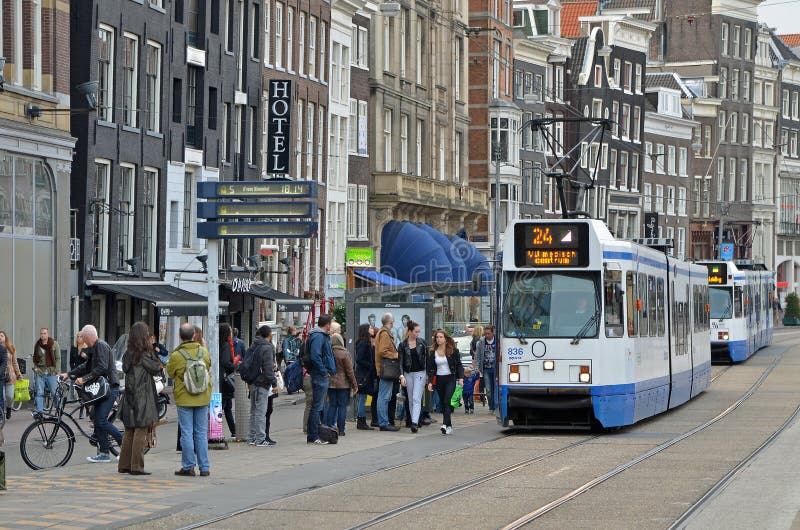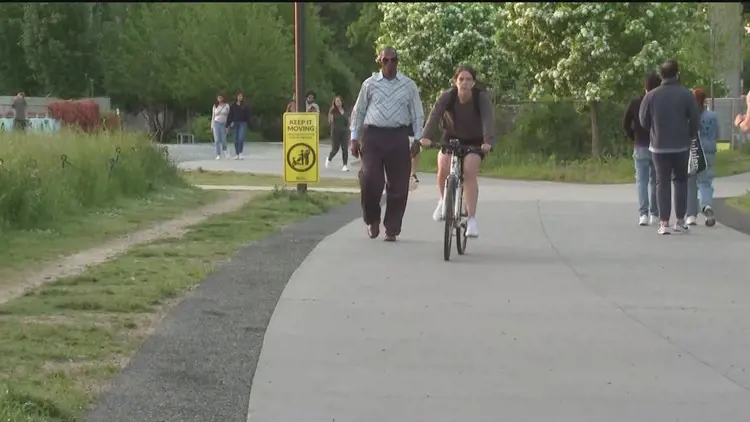The whole reason the Beltline even exists is because it was meant to be a transit corridor. A multiuse trail was also part of the design, so both need to be constructed.
But also, since the land developers jumped into the fray and built their car-oriented buildings off the trail, OF COURSE they want to keep it this way.
I’m sick and tired of the false notion that transit BRINGS IN undesirable effects when the exact opposite has always been true.
Let’s look at their concerns and I’ll chime in with my opinions on why it’s simply not true.
- There will be a heat island effect due to the constrained space from having up to 40 feet of ROW taken up with tracks.
That will consume almost all greenspace between the pedestrian trail and the edge of the Beltline corridor. Most existing trees and meadows will be removed to make room for the Streetcar. Less room for public art. Less room for hanging out. And a lot less room for nature.
- False. The streetcar can be designed with this in mind and have grassy tracks and simple stop infrastructure. Even Houston’s MetroRail tracks cross a fountain and have a small footprint. Clearly this group has never once visited an established streetcar/tram installation anywhere and seen what can be done with the ROW.

- The Eastside Trail already is overcrowded with bikes, runners, walkers, scooters, dogs and all manner of mobility devices. It can be dangerous. We need more room for people — perhaps a wider path, or even separate lanes for “heels and wheels.”
- Yes, because the current trail setup was always intended to be TEMPORARY since the transit part needed to be installed at a later date. The final configuration with tram tracks installed will allow for all that. It’s done in several other countries and even San Francisco, Portland and San Diego all have sections of their LRT systems set up in similar ways. Obviously trams will be moving along at a slower pace while on the Beltway near trail users.
- We question spending the largest portion of Atlanta’s transit investment over the next three decades on a light-rail track that circles destinations rather than takes people to them. The Beltline already serves thousands of people daily as a last-mile, human-powered corridor. There’s little evidence of demand for long trips via rail along that corridor.
- The corridor is intended to be a light rail loop with branches that go out into places like Emory, East Atlanta, Westside Reservoir Park and Campbellton Road. Of course, some of these have been turned into BRT but the good thing about that is it can be converted at a later date to light rail. Just ask Seattle. As for demand for travel– it hasn’t been built yet, but just based on car usage alone, getting from one side of midtown to the other is a big want. Getting from the West End to East Atlanta is a big deal. There will be interfaces with MARTA subway on all sides of the Beltway and we really need a “crosstown” transfer solution that doesn’t involve going through 5 Points every time. Also, points along the loop can BECOME the destination, just ask Chicago, Tokyo, Berlin, and every other city with a looping railway around their CBD.
- Will it harm Beltline businesses?
- Are you serious? The businesses weren’t even there 10 years ago; the overarching reason the developers got interested in building along the corridor in the first place is because of the TOD aspect of it– the multi-use trail wasn’t even a thing yet. So yeah, adding the rails will be what was intended in the first place and ADD TO THE ACCESSIBLILTY of the path! (my 78-year-old mom will not bike nor walk a long distance along the trail, but she’d definitely take the streetcar along the route in a hop-on-hop-off fashion.)
- Is this really Atlanta’s highest transit priority? Streetcar expansion will run through some of the city’s wealthiest and least diverse neighborhoods. In other parts of the city, residents rely heavily on transit as a necessity. They could benefit from better service.
- ALL OF IT is the highest priority. The CBD (downtown/midtown) has suffered way too long from ineffective crosstown transit options. The LRT loop aspect of the beltline is supposed to change all that. Remember, these used to do the same thing for trains what needs to be done for people without cars– get them from once part of the CBD to the other and also facilitate a termination for inbound LRTs from other locations.
- Also fact– MARTA heavy rail probably is too costly to build new lines off of at this point, but links to Cobb and Douglas counties could still be made via LRT and might seem even more palatable if they ran into and terminated on the Beltline. Building the infrastructure needed for this option is key.
- ALL OF IT is the highest priority. The CBD (downtown/midtown) has suffered way too long from ineffective crosstown transit options. The LRT loop aspect of the beltline is supposed to change all that. Remember, these used to do the same thing for trains what needs to be done for people without cars– get them from once part of the CBD to the other and also facilitate a termination for inbound LRTs from other locations.
- Are we betting on a technology of the past? Rail on the Beltline was first proposed in 1999. That was before the invention of Facebook or the iPhone. It was well before ridesharing services, e-bikes, scooter rentals, autonomous vehicles and other innovations disrupted how we get around urban areas.
- I can’t believe we’re conflating modern streetcars with social media evolution. YES, there is still a need for accessing the area physically first. I can’t pedal all the way to the Beltline from Gwinnett. But I can take MARTA rail to Inman Park from Indian Creek (now that we have a bus that serves that station from here). I don’t have a bike and even if I did, I’m not carrying it on the bus/train every time. If I want to visit my uncle in Ormewood/Grant Park I have to catch a bus or two. Once the trail opens on the south end, I guess I could walk, but it’s better if there was an option that was a little faster. Streetcar to the rescue!
- And hey, who’s to say that there wouldn’t be a branch off this part that would serve the Flat Shoals corridor and head out to Lithonia– that has been proposed for decades.
- I can’t believe we’re conflating modern streetcars with social media evolution. YES, there is still a need for accessing the area physically first. I can’t pedal all the way to the Beltline from Gwinnett. But I can take MARTA rail to Inman Park from Indian Creek (now that we have a bus that serves that station from here). I don’t have a bike and even if I did, I’m not carrying it on the bus/train every time. If I want to visit my uncle in Ormewood/Grant Park I have to catch a bus or two. Once the trail opens on the south end, I guess I could walk, but it’s better if there was an option that was a little faster. Streetcar to the rescue!
- The entire 22-mile loop is expected to be completed around 35 years from now at a cost of $2.5 billion. That’s probably optimistic. Where’s the money gonna come from?
- We should just give up because there’s no funding for the whole thing right now? That’s unfortunate but also how literally everything in this country gets built. We’re still waiting for the rest of MARTA to get built from the original 1974 plan. Should we just have threw that one in the trash too? You already know once something is built and used, it rapidly becomes integral, and funding will come. A full Beltline streetcar loop will be something that is rare in this nation and will attract even more development and the money that comes with it. Ask Denver about their similar bet on interurban rail and even our original bet on MARTA –that we only got after Seattle passed on the federal funding. SOME OTHER CITY will get whatever we had coming to us and we’ll continue to live in a car-infested hellscape outside of The Beltline.
And that’s the point I want to make– This is all about the few people who call the first small 5 mile stage of the Beltline home, and not taking anything into account from the many more thousands of people who live around and outside the already completed trail. I know most of the Westside Beltline communities want as much transit that will fit into the ROW because their areas have been neglected far too long. (I also advocated that area along with the Southside Beltline be the first to get redeveloped but of course the area closest to the already activated Virginia Highlands/Poncey Highlands/Cabbagetown section got it first.)



Leave a Reply